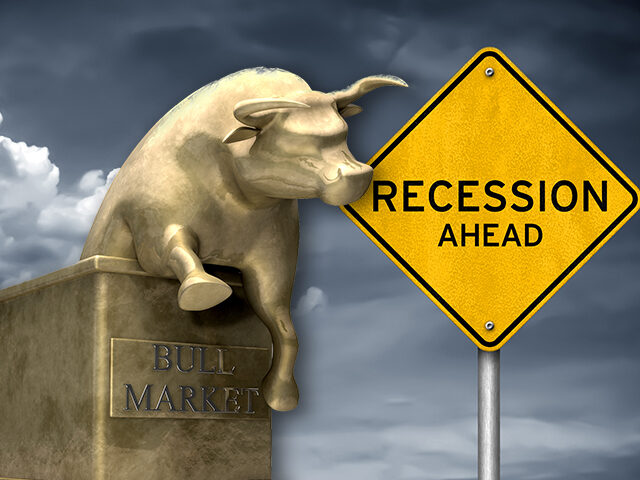The Bull Market Stampedes Over Recession Worries
A funny thing happened on the way to the next recession: stocks stampeded their way to bull market territory.
The S&P 500 has successfully climbed the proverbial “wall of worry” into a cyclical bull market last week, rising above the 20 percent threshold from the October 2022 low on June 8. As such things usually do, the rally has come despite overwhelmingly bearish investor sentiment, depressed consumer confidence, analyst predictions of declining earnings, and the conviction of most economists that the U.S. is just months away from an economic recession. Everything, it seems, is a contrarian indicator.
The market historians tell us this is the S&P’s 27th bull market. Stephen Suttmeier, technical research strategist at Bank of America, recently pointed out that since 1929, cyclical bull markets last 33.6 months on average, with a median of 17.4 months. The average return is 114.4 percent, with a 76.6 percent median. The year after the S&P enters a bull market, the market is higher 65 percent of the time. The average return in that first year is 9.4 percent, and the median return is 14.1 percent.
The average return would put the S&P at 4,700 in June of next year, just short of the all-time high hit in January of 2022. The median return would push the S&P up to 4,900, a new record high.

If you narrow the time frame to only go back to 1950, the results are even stronger. Suttmeier says that rallies of 20 percent or more from recent lows since 1950 have lasted 53.9 months on average, a median of 47.3 months. The average return for those bull markets was 155.25 percent, with a median return of 93.92. The year after the bull market began, stocks were higher 92 percent of the time. The average return was 19.0 percent, and the median return was 17.8 percent. That would equate to the S&P reaching 5,100 for average gains and 5,060 for median gains.
Should You Buy or Sell a Fed Pause?
In recent years, the correct strategy has been to “buy the last rate hike.” That is to say, stocks have tended to rise following a Federal Reserve decision to hold the interest rate steady after a series of hikes.
Michael Hartnett of Bank of America has been pointing out that “sell the last hike” was the correct strategy for stocks while inflation was running high in the 1970s and 1980s. The “buy the last hike” strategy worked better in the 1990s and 2000s because we were in a disinflationary cycle.
So, what should investors do now? The analysis is made more complicated by the fact that Fed officials have been warning for weeks that we are likely not yet at the last rate hike. It seems probable that the Fed will “skip” raising rates this week while signaling that this is not the beginning of an extended “pause” on hikes. Rather, the Fed will likely send the message that it wants more time to observe the economic impact of the 500 basis points of hikes put in place over the past 15 months.
Perhaps before deciding whether the correct strategy is to buy or sell the last hike, we should wait until we can confidently say the last hike is in sight.
Americans Think the Labor Market Is Firming
Last week, we spilled a lot of pixels describing the strength of the labor market and pushing back on the idea that the recent jobs report indicated “softening.” On Monday, the Federal Reserve Bank of New York released its latest Survey of Consumer Expectations showing that the public is forecasting a hot labor market.
The mean probability that the unemployment rate will be higher one year from now decreased by 1.9 percent in May to 40.0 percent, below its 12-month trailing average of 40.6 percent. The mean perceived probability of losing one’s job in the next 12 months decreased by 1.3 percentage points to 10.9 percent, the lowest reading since April 2022 and only 0.1 percentage point above the all-time low. The mean perceived probability of finding a job (if one’s current job was lost) increased from 55.2 percent in April to 56.4 percent in May.
But while jobs are expected to be plentiful, workers are not expecting raises.
The New York Fed reports:
After staying unchanged at 3.0% for five consecutive months, median one-year-ahead expected earnings growth declined to 2.8%. The series has been moving within a narrow range of 2.8% to 3.0% since September 2021. The decline in expected earnings was more pronounced among respondents with no more than a high school education.
Oddly enough, however, the same report says that median expected growth in household income increased by 0.2 percentage points to 3.3 percent. Perhaps we all expect our spouses to bring home a bit more bacon.

COMMENTS
Please let us know if you're having issues with commenting.